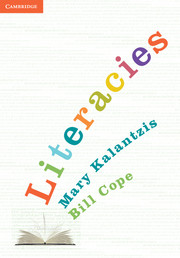Book contents
- Frontmatter
- Contents
- Acknowledgements
- Introduction The work of learning and teaching literacies
- Part A The ‘Why’ of Literacies
- Part B Approaches to Literacies
- Part C The ‘What’ of Literacies
- Chapter 7 Literacies as multimodal designs for meaning
- Chapter 8 Making written meanings
- Chapter 9 Making visual meanings
- Chapter 10 Making spatial, tactile and gestural meanings
- Chapter 11 Making audio and oral meanings
- Part D The ‘How’ of Literacies
- References
- Index
Chapter 7 - Literacies as multimodal designs for meaning
from Part C - The ‘What’ of Literacies
- Frontmatter
- Contents
- Acknowledgements
- Introduction The work of learning and teaching literacies
- Part A The ‘Why’ of Literacies
- Part B Approaches to Literacies
- Part C The ‘What’ of Literacies
- Chapter 7 Literacies as multimodal designs for meaning
- Chapter 8 Making written meanings
- Chapter 9 Making visual meanings
- Chapter 10 Making spatial, tactile and gestural meanings
- Chapter 11 Making audio and oral meanings
- Part D The ‘How’ of Literacies
- References
- Index
Summary
Overview
Meaning-making is a process of representation (sense-making) and communication (in which a message prompt is interpreted by another person). This chapter analyses the design process through which people take available resources for meaning, and use these as building blocks for designing new meanings. Although they are often similar, these meanings are never quite the same as any previous meanings. These ‘redesigned’ meanings then enter the world. At this point the world has been transformed, even if in the smallest of ways. Then the cycle of meaning-making can start over again. Even though historically we have separated out literacies as a separate subject that deals with the mechanics of reading and writing, our processes of meaning are frequently multimodal, bringing together written, visual, spatial, tactile, gestural, audio and oral modes. This is particularly true in the contemporary era. The new digital media are intrinsically multimodal. This chapter suggests an approach to ‘design analysis’. It is a prelude to the five chapters in this section of the book that outline our grammar, or metalanguage, designed to help us understand meaning-making across different modes.
- Type
- Chapter
- Information
- Literacies , pp. 173 - 205Publisher: Cambridge University PressPrint publication year: 2012



